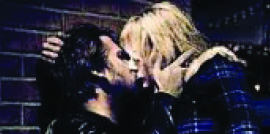By Sam Barron
For guys, it’s become a rite of passage – the very first film you saw with boobies.
For me, that came in seventh grade as my dad hooked up a black box on our TV. This meant we got all the premium channels like HBO, as well as all the pay-per-view channels. PPV channels back then meant I got to see all of 1996’s biggest hits and lots and lots of, for lack of better word, titty movies.
But the first was “Fugitive Rage,” starring acclaimed actress Wendy Schumacher, who as of this writing, has zero Oscar nominations. Her other films include “Animal Instincts III” and “Scorned 2.” She has not worked since 2002.
“Rage” was directed by Fred Olen Ray, whose photo on IMDb, a website for all things movie, shows him holding a cigar. He has directed 128 films, including 19 films with the word “bikini” in the title. (He was my pick to helm “Lincoln,” but Spielberg did OK.)
Anyway, someone kills Schumacher’s sister, or brother. He gets acquitted, and in court, Schumacher kills the guy. She’s sent to jail, where the female prison guard tells her to strip. Which she does.
(Well, first she questions whether she has to strip all the way, and then is told by the female prison guard, “If I told you to do a dance, I’d expect you to do an Irish jig.” I have not seen this movie since 1997 and remember that line of dialogue clear as day.)
And with the removal of her prison jumpsuit, my life – and perspective – suddenly changed forever. Movies involved more than action sequences or comedy.
Titillation has been part of movies from the beginning, although the Hays Code that governed film censorship from 1930 to ’68, did its utmost to filter it out. (Look at a pre-code movie like the 1925 “Ben-Hur,” and you’ll see plenty of male nudity in the famous galley scene.)
But though movies lacked skin in the Hays heyday, it didn’t mean they weren’t erotic. In some ways, showing less made things even hotter.
“You just didn’t see nudity in movies,” says longtime critic Marshall Fine, who reviews films at hollywoodandfine.com. “In movies like ‘The Postman Always Rings Twice’ and ‘Double Indemnity,’ there’s not a lot of sex. That doesn’t mean there wasn’t an erotic charge between these two characters.”
In the late ’50s and ’60s, the production code became irrelevant as Hollywood faced increasing competition from foreign films and television. Movies like “Blowup,” “The Pawnbroker” and “Who’s Afraid of Virginia Woolf?” pushed the sexual envelope.
Enforcement of the Hays Code became impossible, and on Nov. 1, 1968, the Motion Picture Association of America established its rating system, which is still in place today.
The ’60s and ’70s also saw the rise of skin flicks. These movies were shot on film, had plots and dialogue and featured simulated sex but no male nudity.
The 1980s brought the ascent of cable, with channels like Cinemax and Showtime seemingly competing on a weekly basis for best soft-core porn flick. The explosion of the Internet in the 1990s made hard-core pornography easily accessible, further diluting the word “erotica.”
“Everything has been devalued,” Fine says. “There’s so much pornography on the Internet. I don’t think mainstream movies even try to compete with that. There’s a different way to do it.”
Despite the availability of so much porn, there are still some stigmas attached to sex in Hollywood.
Halle Berry made headlines when she bared her breasts in “Swordfish,” while Chloe Sevigny was fired from her agency for performing fellatio on Vincent Gallo in “The Brown Bunny.” Even today, an NC-17 rating can mean the kiss of death for a movie.
“Sex is still the original sin,” Fine says. “It’s always fascinated us. It’s a primal force.”
In 2010, “Blue Valentine” was slapped with an NC-17 for essentially having an uncomfortable sex scene. Despite the easy accessibility to any type of porn, Fine says this shows that a segment of the population will always be uncomfortable with sex.
“There are always people for whom any flash of skin or stimulation of sexuality is too much,” Fine says. “These people are living in a fantasy world and trying to deny reality. No one is forcing them to see these movies, but they want to prohibit the rest of us from seeing it.”
Across the pond, showing nudity in European films isn’t a shock but an expectation, with actresses like Catherine Deneuve, Juliette Binoche and Marion Cotillard making men (and women) go “ooh la la.” In America, a boob at the Super Bowl caused national outrage.
“We come from the Puritans,” Fine says. “Even though it was 400 years ago, that stuff dies hard. They didn’t have that in Europe. They have a much more sophisticated and much less uptight view of nudity in sex and films. It doesn’t scare them. We’ll always be lagging behind. It’s endemic in our nature.”
Fine, who counts “The Last Seduction,” “The Hot Spot,” “Body Heat” and “Bound” as some of his favorite erotic films, says the accessibility of porn means that mainstream films simply cannot sell themselves as sex anymore. “Shame,” which received an NC-17 rating in 2011 for displaying Michael Fassbender’s considerable assets, wooed the art-house crowd.
“I can’t think of the last blockbuster that was really sexy,” Fine says. “Sex sells, but it doesn’t sell to a mass audience like transforming robots, aliens from outer space and zombies.”


